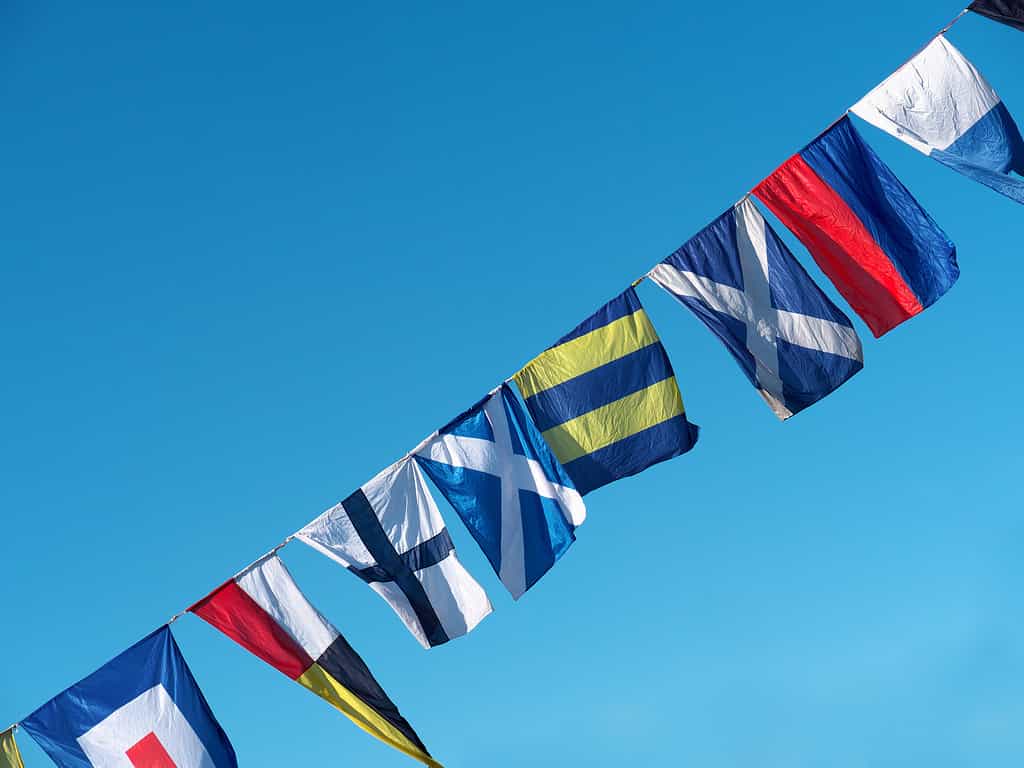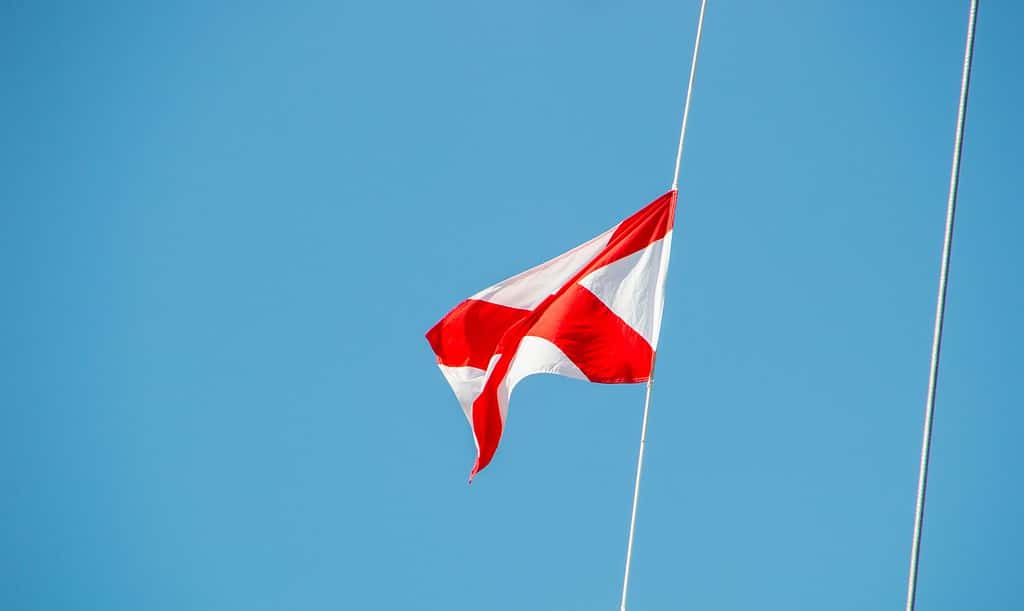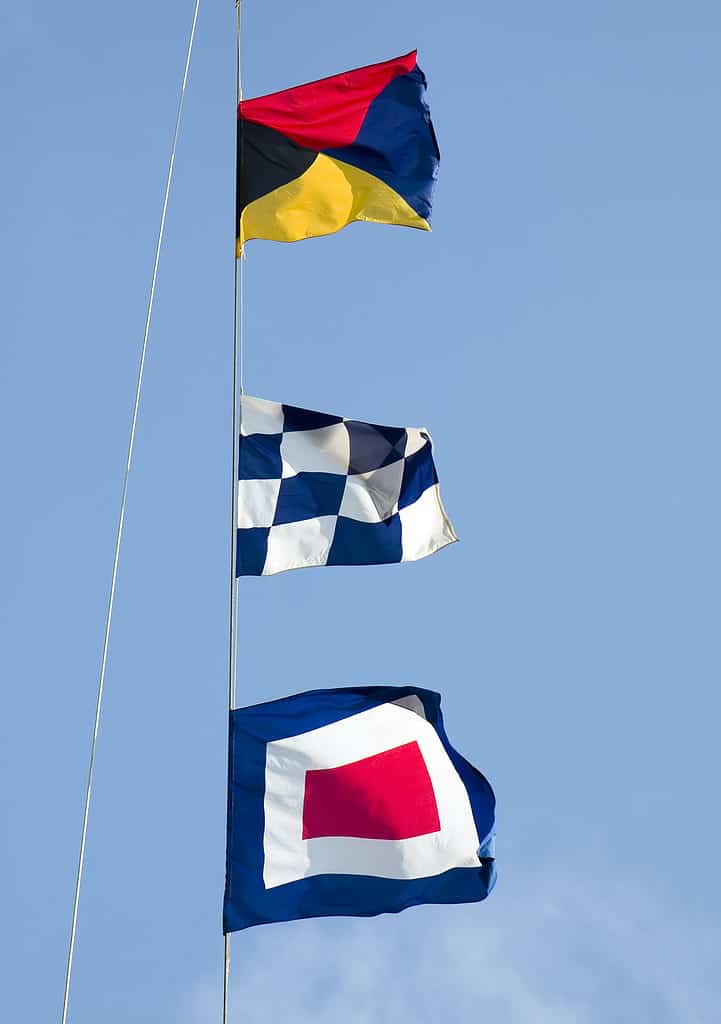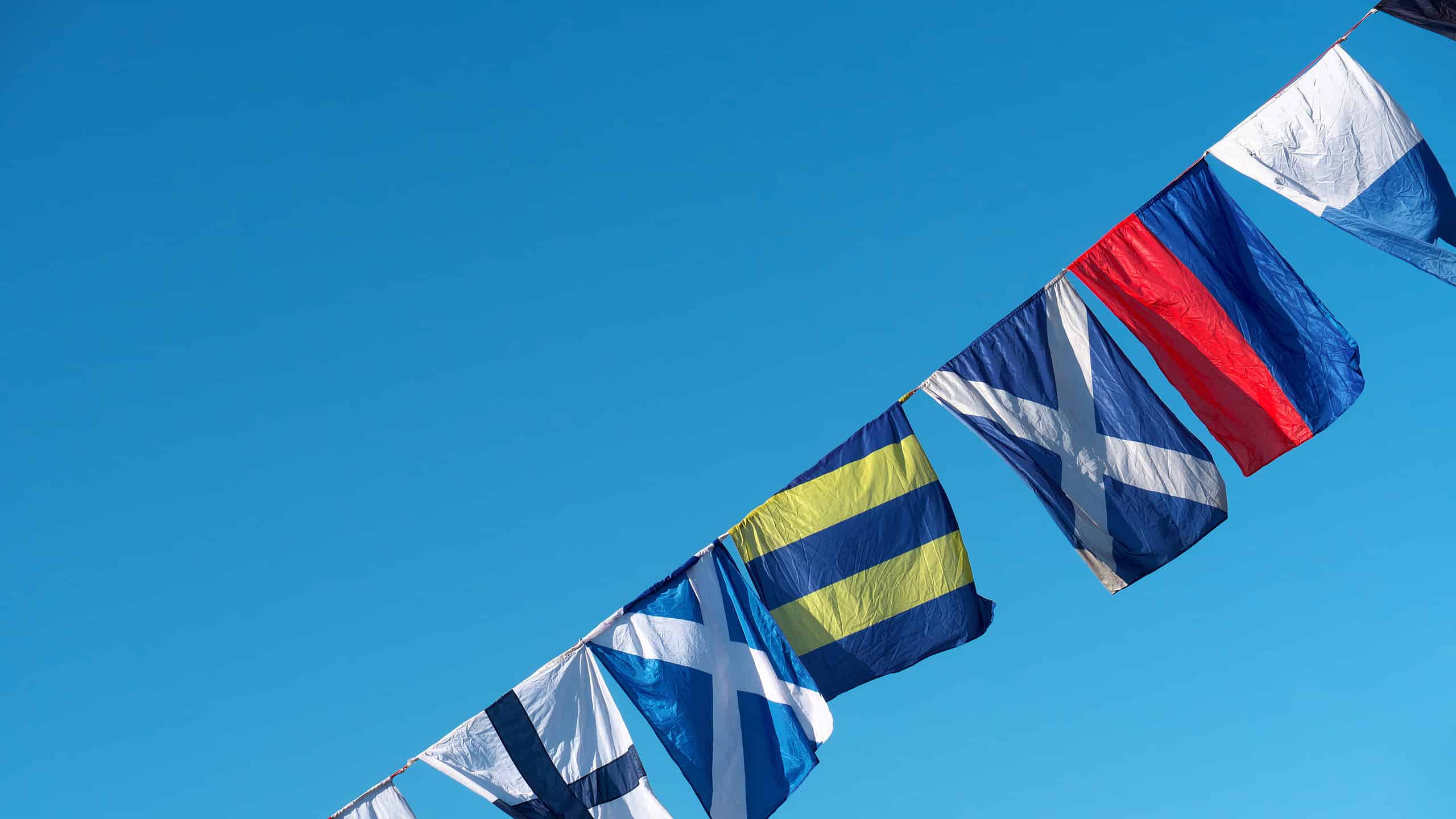Nautical flags are used by ships and boats to communicate messages visually. These flags are essential for maritime communication, especially when verbal communication is difficult or impractical. The International Code of Signals (ICS) is the most widely used system of nautical flags. It consists of 40 flags: 26, each representing a letter of the English alphabet, from A to Z, 10 numeral pennants, and 4 substitute flags. In addition to the individual letter or number, each flag conveys a specific message or command. Numbered flags can be used individually or combined with other flags to communicate specific numerical values or quantities. They are particularly useful in situations where precise numerical information needs to be conveyed quickly and visually, such as indicating distances, quantities of goods, or navigational data. Keep reading to discover how to identify these 40 common nautical flags and their meanings.

Nautical flags are a system of flags used by ships and boats to communicate messages visually.
©Igor Shoshin/Shutterstock.com
The International Code of Signals
The development of the International Code of Signals played a crucial role in establishing a standardized and internationally recognized system for maritime communication. It continues to evolve, ensuring the efficient exchange of information and enhancing safety in the maritime domain. Prior to the establishment of the ICS, various signaling systems were used for communication at sea. Semaphore flags, signal lamps, and other visual signaling methods were employed, but there was no universal system that allowed for effective communication between ships of different nations.
In 1817, a captain in the British Royal Navy, Frederick Marryat, developed Marryat’s Code. This code was used for communication between naval ships and merchant vessels. It used a set of flags but lacked standardization and was not universally recognized. In 1855, the British Board of Trade designed a system called the Commercial Code. Their goal was to establish an international system for maritime communication. The result of these efforts was the creation of the International Code of Signals. It was officially adopted in 1865 and consisted of a set of flags representing letters of the alphabet, numerals, and common phrases.
Over the years, the International Code of Signals expanded to include additional flags, signals, and meanings. The code underwent revisions to accommodate technological advancements and changing needs in maritime communication. The International Code of Signals is recognized and used by maritime organizations and authorities worldwide. It is employed by ships, naval forces, coast guards, and other maritime entities for effective communication at sea.

The International Code of Signals is recognized and used by maritime organizations and authorities worldwide. From left: India, Bravo, Juliet, Lima
©ABB Photo/Shutterstock.com
40 Common Nautical Flags and Their Meanings: Comprehensive Table
The following table contains all 40 common nautical flags in the International Code of Signals and their meanings:
| Flag name | Signal/ Description |
|---|---|
| Alpha | I have a diver down; keep well clear; maintain slow speed. White with blue swallowtail; or a red flag dissected by a diagonal white stripe. |
| Bravo | I am taking in, discharging, or carrying dangerous goods. Solid red with swallowtail |
| Charlie | Yes or Affirmative. Vertical stripes (l-r): Blue/White/Red/White/Blue |
| Delta | Keep clear of me; I am maneuvering with difficulty. Vertical stripes(l-r): Yellow/Blue/Yellow |
| Echo | I am altering my course to starboard. Vertical stripes (l-r) Red/Blue |
| Foxtrot | I am disabled; communicate with me. White with a red diamond |
| Golf | I require a pilot. Vertically striped alternating yellow and blue with a total of six stripes. |
| Hotel | There is a pilot onboard. Left: White; Right: Red |
| India | I am altering my course to port. Yellow flag with a black circle in the center. |
| Juliet | I am on fire and have dangerous cargo; keep clear. Horizontal Stripes (l-r): Blue/White/Blue |
| Kilo | I wish to communicate with you. Left: Yellow; Right: Blue |
| Lima | You should stop your vessel instantly. Four Square: Top (l): Yellow, (r): Black; Bottom (l): Black (r): Yellow |
| Mike | My vessel is stopped; making no way through the water. Blue flag with white X |
| November | No or Negative. Blue and white checkboard pattern with 16 squares: 8 Blue, 8 white, alternating. |
| Oscar | Man overboard Top triangle: Red Bottom triangle: Yellow |
| Papa | All personnel return to ship; vessel is about to proceed to sea. Blue flag with a white square in the center |
| Quebec | My ship is healthy; I request free pratique. Solid Yellow flag |
| Romeo | All personnel return to ship; vessel is about to proceed to sea. Red flag with a yellow cross |
| Sierra | Engines are going astern. White flag with a blue square in the center |
| Tango | Keep clear; engaged in pair trawling. / Do not pass me. Vertically striped, (l-r): Red, White, Blue |
| Uniform | You are running into danger. Four alternating squares: 2 red; 2 white. The red squares are top left and bottom right. |
| Victor | I require assistance. A white flag with a red X |
| Whisky | I require medical assistance. A blue flag with a white rectangle in the center. There is a red square in the white rectangle. |
| X-Ray | Stop carrying out your intentions and watch for my signals. A white flag with a blue cross |
| Yankee | I am dragging my anchor. Diagonally striped red and yellow flag with 10 stripes: 5 red and 5 yellow |
| Zulu | I require a tug. The flag is divided into 4 triangles, with their points meeting in the center of the flag. From top, clockwise: Yellow-Blue-Red-Black |
| 0 (zero) | Vertically striped pennant (l-r): Yellow-Red-Yellow |
| 1 (one) | White pennant with a red circle on the left |
| 2 (two) | Blue pennant with a white circle on the left |
| 3 (three) | Vertically striped pennant (l-r): Red-White-Blue |
| 4 (four) | Red pennant quartered by a white cross |
| 5 (five) | Left 1/2: Yellow; Right 1/2: Blue |
| 6 (six) | Horizontally striped. Top: Black, Bottom: White |
| 7 (seven) | Horizontally striped. Top: Yellow, Bottom: Red |
| 8 (eight) | White pennant quartered by a red cross |
| 9 (nine) | Top left 1/4: White; Top right 1/4: Black; Bottom left 1/4:Red; Bottom right: Yellow |
| 1st Substitute | communicates messages regarding safety of navigation and related matters. Yellow triangle pennant with blue outline on top and bottom. |
| 2nd Substitute | Absence of the chief or staff (when in port) Left: Blue Right to point: white |
| 3rd Substitute | Absence of flag officer or unit commander (when in port); Triangular pennant with horizontal white stripes flanking a center black stripe. |
| 4th Substitute | Code and Answering Pennant alternating vertical red and white stripes with 3 red and 2 white stripes |

The Victor flag signals a need for assistance.
©Bruno Martins Imagens/Shutterstock.com
40 Common Nautical Flags and Their Meanings: Obsolete?
Are the 40 common nautical flags of the ICS obsolete? With the advent of modern technology, such as radio communication and digital devices, the practical use of nautical flags for communication has diminished to some extent. However, nautical flags continue to be used in maritime settings. The International Code of Signals, which includes nautical flags, remains a widely recognized and standardized system of communication at sea. It ensures a common language for maritime communication, especially in situations where verbal communication may be challenging due to language barriers or poor radio reception.
Flags work When Technology Fails
In cases where electronic communication systems fail, nautical flags serve as a reliable backup method. They can be used to convey critical messages and signals, especially during emergencies or when other forms of communication are unavailable. Certain nautical flags, like the Oscar flag for Man overboard or the Juliet flag meaning I am on fire and have dangerous cargo; keep clear, are recognized distress signals. These flags can be used to attract attention and indicate a need for immediate assistance, even when electronic communication devices are not functioning properly.
Nautical flags have a rich history and are an integral part of maritime traditions. They are still used in ceremonial events, regattas, maritime festivals, and yacht races, adding to the aesthetic appeal and cultural significance of these occasions. Nautical flags, with their vibrant colors and distinct designs, provide visual cues that can aid in the identification and recognition of vessels from a distance. They contribute to the overall safety and navigation of maritime traffic, particularly in situations where ships need to be visually distinguished or where radio communication is limited. Though modern technology has reduced the reliance on nautical flags as a primary means of communication, their importance persists.

This vessel just might be in crisis. Top-to-bottom: Zulu, November, Whiskey.
©Lagui/Shutterstock.com
Thank you for reading! Have some feedback for us? Contact the AZ Animals editorial team.








